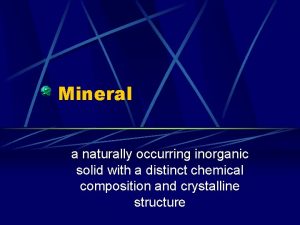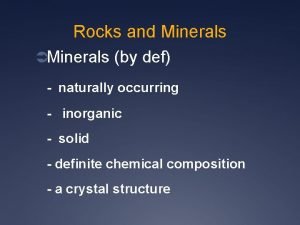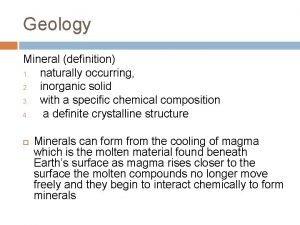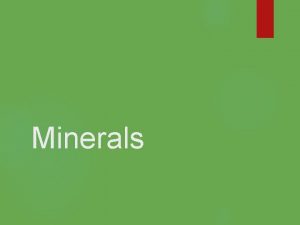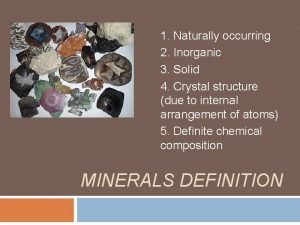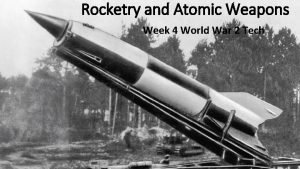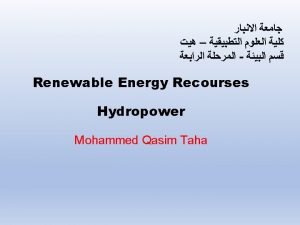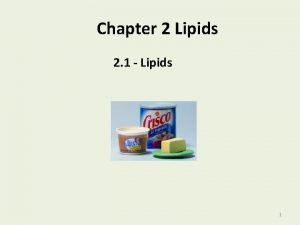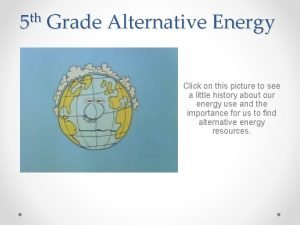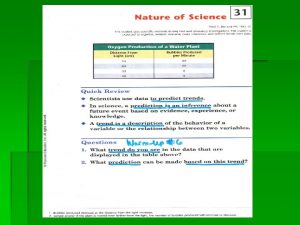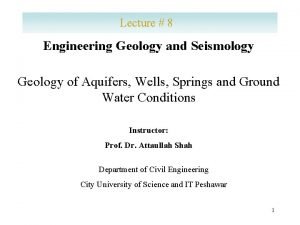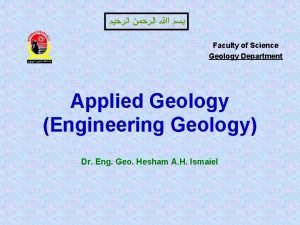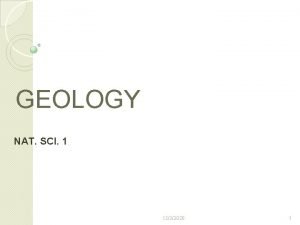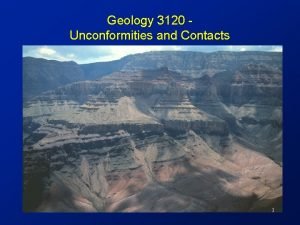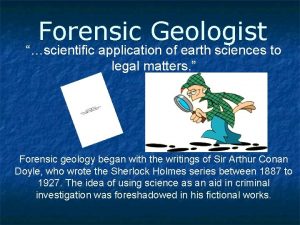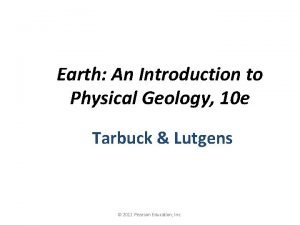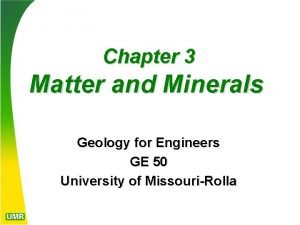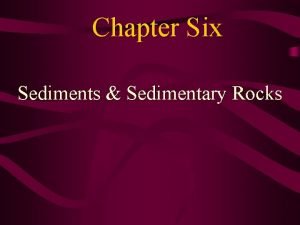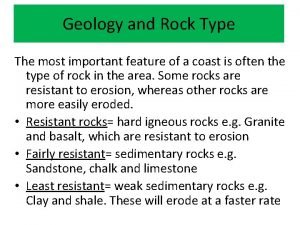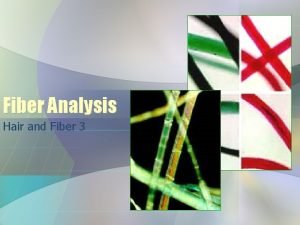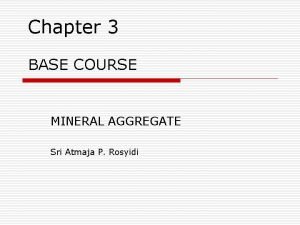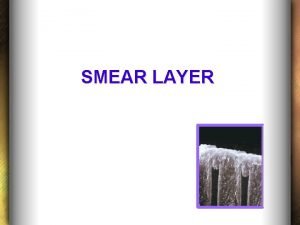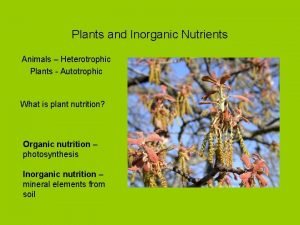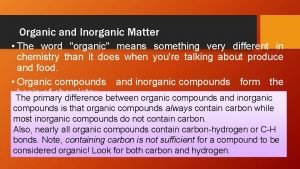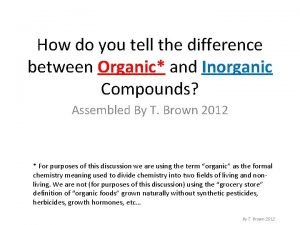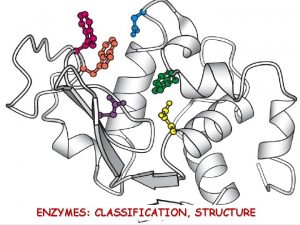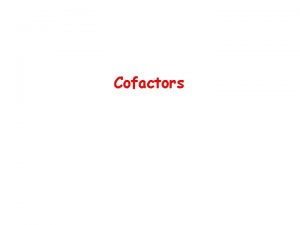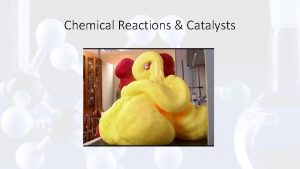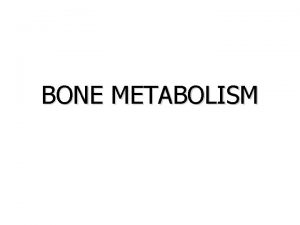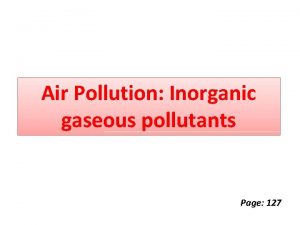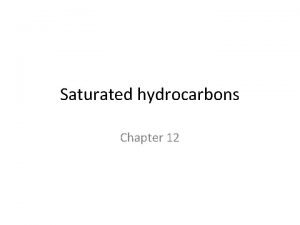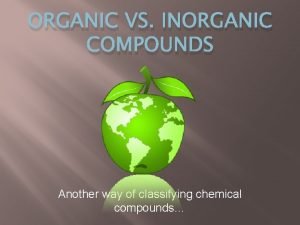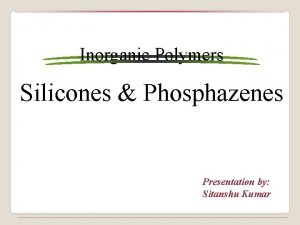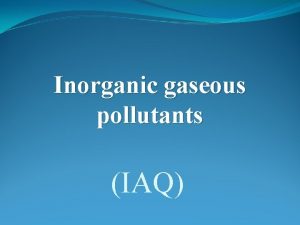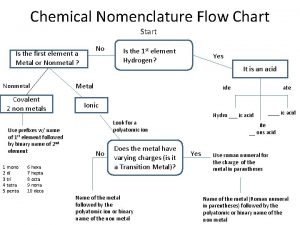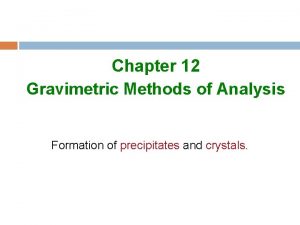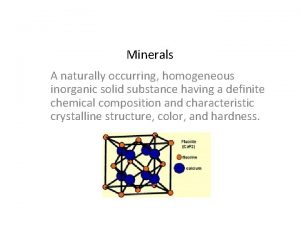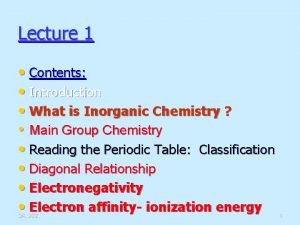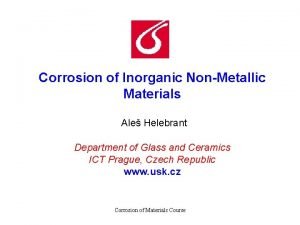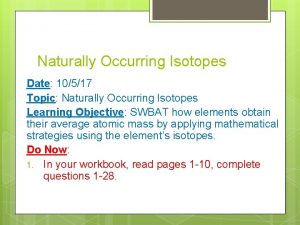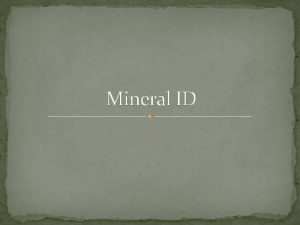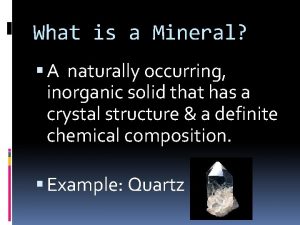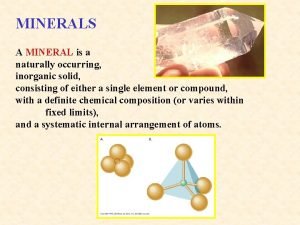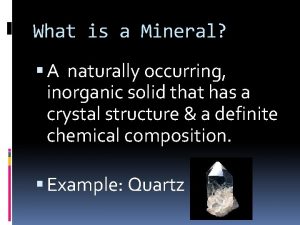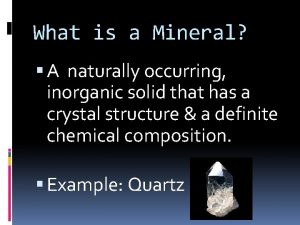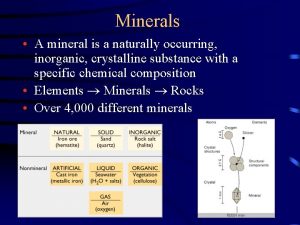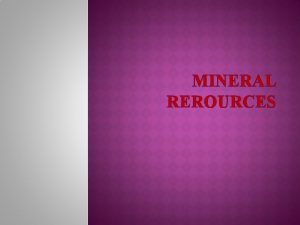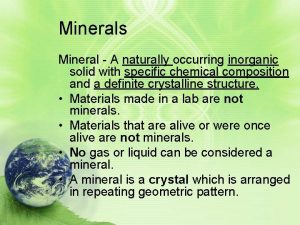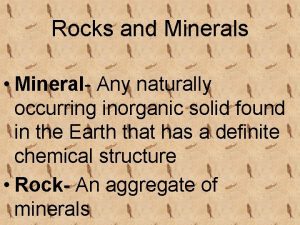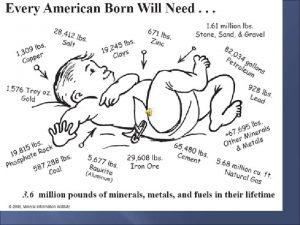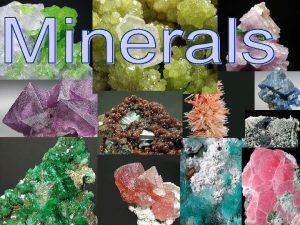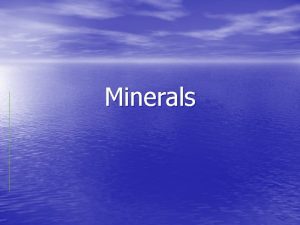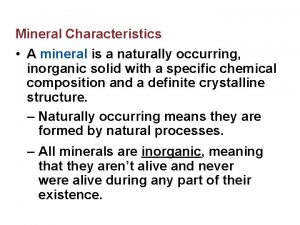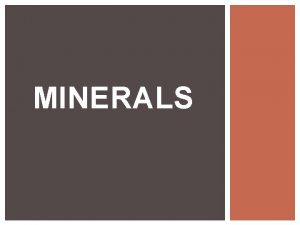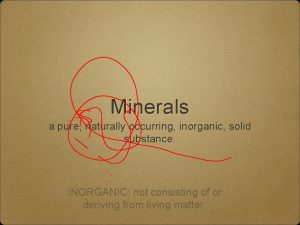Geology Mineral definition 1 naturally occurring 2 inorganic






























































- Slides: 62

Geology Mineral (definition) 1. naturally occurring, 2. inorganic solid 3. with a specific chemical composition 4. a definite crystalline structure Minerals can form from the cooling of magma which is the molten material found beneath Earth’s surface as magma rises closer to the surface the molten compounds no longer move freely and they begin to interact chemically to form minerals

Geology Minerals form by combining elements together to create compounds. Each compound is unique and has specific properties that separate it from other compounds Minerals are like rocks because all rocks are made of minerals


Mineral Properties Streak is easily determined by rubbing the mineral across an unglazed porcelain plate

Mineral Properties Streak is used to distinguish pyrite from gold

Mineral Properties Luster is the way a mineral reflects light from its surface and is caused by differences in mineral chemical compositions

Mineral Properties Either metallic or nonmetallic (dull, pearly, waxy, silky)

Mineral Properties Texture describes how a mineral feels to the touch � Rough, smooth, ragged, greasy, soapy, glassy

Mineral Properties Hardness is a measure of how easily a mineral can be scratched and is determined by the arrangement of it’s atoms.

Mineral Properties The Mohs hardness scale is used to compare a sample to the hardness of ten known minerals

Mineral Properties Cleavage determines whether a mineral will split easily and evenly along one or more flat planes

Mineral Properties Mica has perfect cleavage in one direction Halite has cubic cleavage (3 planes)

Mineral Properties Fracture means the mineral is tightly bonded and breaks with rough or jagged edges � Quartz has fracture

Mineral Properties Specific Gravity compares the weight of the mineral to an equal volume of water at 4 degrees C

Mineral Properties Special Properties such as light reflection and reactions to acids are also useful tools

Mineral Properties Calcite fizzles when in contact with HCl

Mineral Properties Calcite also can cause double images

Mineral Properties Magnetite will attract iron

Mineral Properties Sulfur produces a rotten egg odor

Geology Small crystals means the magma cooled rapidly Large crystals means the magma cooled more slowly

Geology Silicates are the most abundant group (96%) containing the two most abundant elements in the crust Silicon (Si) and Oxygen (O)

Geology Quartz and Feldspar are the most abundant minerals found in Earth’s crust

Geology Carbonates are minerals composed of one or more metallic elements with the carbonate compound CO 3 ( 1 atom of carbon and 3 atoms off oxygen)

Geology Carbonates are the primary minerals in rocks such as limestone, coquina, and marble Limestone Coquina Marble

Uses for Earth Materials Nearly every single thing we use today comes from Earth directly or indirectly. The following is a list of minerals and ores

Uses for Earth Materials Name of mineral/ore Use(s) Quartz (mineral) Glass, watches

Uses for Earth Materials Feldspar (mineral) Toothpaste

Uses for Earth Materials Calcite (mineral) Neutralizing acids

Uses for Earth Materials Mica (mineral) Lampshades, insulation, makeup

Uses for Earth Materials Pyrite (ore) Iron

Uses for Earth Materials Talc Baby powder

Uses for Earth Materials Diamonds -- Used for gemstones and Grinding drilling and polishing in industry.

Uses for Earth Materials Magnetite (Iron ore)---- Iron Ore used for Iron products

Uses for Earth Materials Hematite(Iron oxide)----- Used for Iron products

Uses for Earth Materials Galena- Is a lead ore lead is used for Lead acid batteries

Uses for Earth Materials Graphite --- Used for pencil lead, and as a lubricant

Uses for Earth Materials Sulfur-----Fertilizers, Pharmaceuticals and Sulfuric acid

Uses for Earth Materials Bauxite Aluminum

Virginia’s Important Resources Coal Energy

Virginia’s Important Resources Gravel/stone (all) Road Construction

Virginia’s Important Resources Limestone Concrete

Virginia’s Important Resources Granite Building materials

Virginia’s Important Resources silica electronics

Virginia’s Important Resources zirconium & titanium advanced metallurgy

What are Rocks? A rock is a naturally occurring solid mixture of one or more minerals, or organic matter Rocks are classified by how they are formed, their composition, and texture Rocks change over time through the rock cycle

Igneous Rocks Igneous rock begins as magma. Magma can form: When rock is heated When pressure is released When rock changes composition Magma freezes between 700 °C and 1, 250 °C Magma is a mixture of many minerals http: //www. fi. edu/fellows/payton/rocks/create/igneous. htm

Igneous Rocks Felsic: light colored rocks that are rich in elements such as aluminum, potassium, silicon, and sodium Mafic: dark colored rocks that are rich in calcium, iron, and magnesium, poor in silicon Coarse-grained: takes longer to cool, giving mineral crystals more time to grow Fine-grained: cools quickly with little to no crystals

Igneous Rocks Coarse-Grained Fine-Grained Felsic Granite Rhyolite Mafic Gabbro Basalt

Igneous Rocks � � Intrusive Igneous Rocks: magma pushes into surrounding rock below the Earth’s surface Extrusive Rocks: forms when magma erupts onto the Earth’s surface (lava), cools quickly with very small or no crystals formed http: //www. windows. ucar. edu/tour/link=/earth/geology/ig_intrusive. html&edu=high&fr=t

Igneous Rocks Obsidian is a dark-colored volcanic glass that forms from the very rapid cooling of molten rock material. It cools so rapidly that crystals do not form. Is this rock Felsic or Mafic? Is it fine-grained or coarse-grained? Is this rock Intrusive or Extrusive? Mafic, fine grained, extrusive

Sedimentary Rocks Sedimentary rock is formed by erosion Sediments are moved from one place to another Sediments are deposited in layers, with the older ones on the bottom § The layers become compacted and cemented together http: //www. fi. edu/fellows/payton/rocks/create/sediment. htm

Sedimentary Rock § Sedimentary Rocks are formed at or near the Earth’s surface § No heat and pressure involved § Strata – layers of rock § Stratification – the process in which sedimentary rocks are arranged in layers

Sedimentary Rock Clastic – made of fragments of rock cemented together with calcite or quartz Breccia is a term most often used for clastic sedimentary rocks that are composed of large angular fragments (over two millimeters in diameter). The spaces between the large angular fragments can be filled with a matrix of smaller particles or a mineral cement that binds the rock together.

Sedimentary Rock Chemical sedimentary – minerals crystallize out of solution to become rock Rock Salt is a chemical sedimentary rock that forms from the evaporation of ocean or saline lake waters. It is also known by the mineral name "halite". It is rarely found at Earth's surface, except in areas of very arid climate. It is often mined for use in the chemical industry or for use as a winter highway treatment. Some halite is processed for use as a seasoning for food. The specimen shown above is about two inches (five centimeters) across.

Sedimentary Rock Organic sedimentary – remains of plants and animals Limestone is a sedimentary rock composed primarily of calcium carbonate (Ca. CO 3) in the form of the mineral calcite. It most commonly forms in clear, warm, shallow marine waters. It is usually an organic sedimentary rock that forms from the accumulation of shell, coral, algal and fecal debris.

Sedimentary Rock Organic sedimentary – remains of plants and animals Coal is an organic sedimentary rock that forms from the accumulation and preservation of plant materials, usually in a swamp environment. Coal is a combustible rock and along with oil and natural gas it is one of the three most important fossil fuels.

Metamorphic Rock § Meaning to change shape § Changes with temperature and pressure, but remains solid § Usually takes place deep in the Earth http: //www. fi. edu/fellows/payton/rocks/create/metamorph. htm

Metamorphic Rocks Contact Metamorphism – heated by nearby magma Increased temperature changes the composition of the rock, minerals are changed into new minerals Hornfels is a fine-grained nonfoliated metamorphic rock produced by contact metamorphism http: //www. windows. ucar. edu/tour/link=/earth/geology/meta_contact. html&edu=h igh&fr=t

Metamorphic Rocks § § Regional Metamorphism – pressure builds up in rocks that is deep within the Earth Large pieces of the Earth’s crust collide and the rock is deformed and chemically changed by heat and pressure http: //www. windows. ucar. edu/tour/link=/earth/geology/meta_regional. html&edu=high&fr=t

Metamorphic Rock Foliated - contain aligned grains of flat minerals Gneiss is foliated metamorphic rock that has a banded appearance and is made up of granular mineral grains. It typically contains abundant quartz or feldspar minerals.

Metamorphic Rock Non-Foliated – mineral grains are not arranged in plains or bands Marble is a nonfoliated metamorphic rock that is produced from the metamorphism of limestone. It is composed primarily of calcium

Metamorphic Rock Determine if the following rock samples are foliated or non-foliated: Amphibolite Quartzite Phyllite Foliated
 Naturally occurring inorganic solid material
Naturally occurring inorganic solid material Naturally occurring mineral
Naturally occurring mineral Inorganic geology definition
Inorganic geology definition A narrow channel or slab of a mineral
A narrow channel or slab of a mineral Inorganic mineral definition
Inorganic mineral definition Heaviest naturally occurring element
Heaviest naturally occurring element Hydroelectric power disadvantages
Hydroelectric power disadvantages Naturally occurring areas of hydrothermal resources
Naturally occurring areas of hydrothermal resources Largest naturally occurring element
Largest naturally occurring element Steroid nucleus structure
Steroid nucleus structure Naturally occurring areas of hydrothermal resources
Naturally occurring areas of hydrothermal resources Naturally occurring antibodies
Naturally occurring antibodies Is a naturally occurring association among specific things
Is a naturally occurring association among specific things Find the probability of z occurring in the indicated region
Find the probability of z occurring in the indicated region What process is occurring
What process is occurring Find the probability of z occurring in the indicated region
Find the probability of z occurring in the indicated region Importance of inorganic chemistry in pharmacy
Importance of inorganic chemistry in pharmacy Confined and unconfined aquifer
Confined and unconfined aquifer Geology earth science definition
Geology earth science definition Geology earth science definition
Geology earth science definition Geology definition
Geology definition Stenos principles
Stenos principles Forensic geology definition
Forensic geology definition Radioactivity definition geology
Radioactivity definition geology Directions of cleavage
Directions of cleavage Lithification definition geology
Lithification definition geology Concordant geology definition
Concordant geology definition Hair and fiber analysis
Hair and fiber analysis Aashto m 147
Aashto m 147 Naturally acquired passive immunity definition
Naturally acquired passive immunity definition Composition of smear layer
Composition of smear layer Charring test of organic and inorganic compounds
Charring test of organic and inorganic compounds Inorganic plant
Inorganic plant Inorganic chemistry vs organic chemistry
Inorganic chemistry vs organic chemistry Organic vs inorganic molecules
Organic vs inorganic molecules Which compound is inorganic
Which compound is inorganic Importance of organic compounds
Importance of organic compounds Organic molecules vs inorganic molecules
Organic molecules vs inorganic molecules What is inorganic matter
What is inorganic matter Organic and inorganic cofactors
Organic and inorganic cofactors Organic vs inorganic compounds
Organic vs inorganic compounds Classification of coenzyme
Classification of coenzyme Bottle gum method
Bottle gum method Organic and inorganic cofactors
Organic and inorganic cofactors Inorganic catalyst vs enzyme
Inorganic catalyst vs enzyme Phospoholipid
Phospoholipid Binomial nomenclature worksheet
Binomial nomenclature worksheet Inorganic gaseous pollutants of air
Inorganic gaseous pollutants of air Advanced inorganic chemistry lecture notes
Advanced inorganic chemistry lecture notes C10h22 organic or inorganic
C10h22 organic or inorganic Organic vs inorganic compounds
Organic vs inorganic compounds Silicones and phosphazenes pdf
Silicones and phosphazenes pdf Inorganic gaseous pollutants of air
Inorganic gaseous pollutants of air Inorganic content of calculus
Inorganic content of calculus Inorganic nomenclature flow chart
Inorganic nomenclature flow chart Mixed crystal formation in gravimetric analysis
Mixed crystal formation in gravimetric analysis Mechanical entrapment coprecipitation
Mechanical entrapment coprecipitation Organic growth vs inorganic growth
Organic growth vs inorganic growth Inorganic growth disadvantages
Inorganic growth disadvantages Homogeneous inorganic substances
Homogeneous inorganic substances Introduction to inorganic chemistry
Introduction to inorganic chemistry Inorganic non metallic materials examples
Inorganic non metallic materials examples Inorganic nomenclature flow chart
Inorganic nomenclature flow chart
